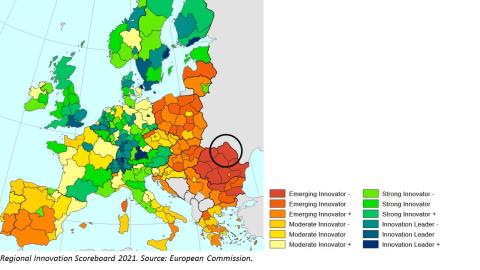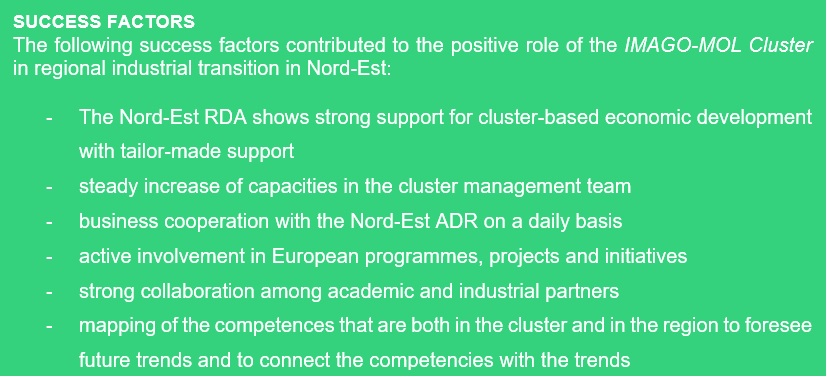Digital Transition and Resilience in Romania's Health Sector
Summary: The Nord-Est Regional Innovative Cluster for Structural and Molecular Imaging (IMAGO-MOL) is the only medical imaging cluster in Romania and the EU. The cluster is significantly driven by research and focuses on enhancing cooperation between industry and academia in the ICT and health sector with the aim to provide high quality healthcare services. IMAGO-MOL successfully lobbied the regional government to have eHealth and precision medicine become integral parts of the regional innovation strategy (RIS3 strategy), labelled as a sub-niche under the “catalyst area” health sector. The focus on these digital priority areas and the related digital transition of the sector contributed to the building of resilience, as the more individual design of the digital systems in the health sector has led to more economic robustness of the region.
The Nord-Est Region
 sdecoret/AdobeStock
sdecoret/AdobeStock
In the far north-east of Romania is the Nord-Est region. It is organised into the six counties of Bacău, Botoșani, Iași, Neamț, Suceava and Vaslui. With approximately 3.3 million inhabitants and an area of almost 37,000 km², it is the largest region in Romania in terms of both population and surface area.Nevertheless, with a GDP of 7,200 Euro per inhabitant, it is also one of the poorest regions in Romania (11,500 Euro per inhabitant). This is also reflected in the European Commission's Regional Innovation Scoreboard 2021, in which the Nord-Est region is listed as an emerging innovator with one of the lowest scores for innovation.
In 2013, the Nord-Est region was the first region to implement a smart specialisation strategy in Romania – RIS3 North-East. In close cooperation with the regional development agencies and all regional clusters, Romania is currently developing the second programme period of the RIS3- strategy. The regional development agencies, like the Agentia pentru Dezvoltare Regionala Nord-Est (ADR Nord-Est) developed the RIS3 2021-2027 based on the Entrepreneurial Discovery Process methodology in order to anchor the specific needs of the regions in the current programme period (2021-2027).

INDUSTRIAL ECOSYSTEMS
Due to the historical focus on traditional industries on the one hand, and the increasing relevance of innovative technologies on the other, the Nord-Est region features a broad spectrum of industry sectors. However, based on the development of the RIS3 strategy, six future-oriented and dominant industrial ecosystems can be identified:
1. Agri-Food (and Wood Industry)
2. Textiles
3. Tourism
4. Renewable Energy (Energy & Environment)
5. Digital (IT&C Sector)
6. Health
STRATEGIC CHALLENGES OF THE REGION
Because of the region’s challenging geographical situation with a mix of hilly, plain and mountain areas, finding suitable transport routes poses a significant challenge to the local industry. In the last few years, a brain drain of well-educated workers and students, amplified by the region’s unfavourable demographics, has become an additional burden for the region's innovative upswing.
With regard to strategic challenges, the RIS3 strategy higlights four major societal challenges for the region, including potential solutions:
1. Healthy aging, demographics and well-being
- societal challenge: Maintaining active, efficient and safe treatments, using the therapeutic effects of food and probiotics, developing ecotourism
- sector challenge: Public access to a wide range of medical information
--> solution: Development of integrated IT systems
2. Food security, sustainable agriculture and bioeconomy
- societal challenge: The bioeconomy involves the complete and complex capitalisation of renewable natural resources
- sector challenge: Inefficient and unsustainable exploitation of resources, sensitive areas and protected areas in the Nord-Est region
--> solution: Development of circular economy based on short value chains, in micro-regions
3. Clean, effective and safe energy
- societal challenge: Measures to improve energy efficiency through production methods and rational use of energy
- sector challenge: Inefficient and unsustainable exploitation of resources
--> solution: Technologies for the production and recovery of energy from alternative sources
4. Safe and secure water
- societal challenge: Resource efficiency and protection of aquatic ecosystems through innovation
- sector challenge: Water treatment
--> solution: Wastewater treatment technologies
In order to meet these challenges, regional bodies have launched a stakeholder process in which regional clusters play a particularly important role in solving these challenges.
CLUSTER POLICY and CLUSTERS
In Romanian legislation clusters are defined in the Government Decision 918:2006 – Impact Programme, according to which “clusters are groupings of producers, users and/or beneficiaries aiming at transferring EU good practice in order to increase the competitiveness of industrial partners.”
At the beginning of 2020, 76 cluster initiatives were recorded by the Directorate for Industrial Policy and Environment of the Ministry of Economy, Trade and Business Environment, which is the responsible unit for cluster development as part of the industrial policy.
Of the 76 cluster initiatives in Romania, 11 are located in the Nord-Est region (+1 representative of a national cluster). They all bring together the relevant stakeholders in the above-mentioned six industrial ecosystems and provide tailor-made support to facilitate digital and green transition and the building of economic resilience. This support is based on a strong collaboration between the cluster initiatives and the regional development agency (Agentia pentru Dezvoltare Regionala Nord-Est - ADR) in their daily business.
While there exists no explicit national cluster strategy in Romania, clusters are an integral part of the regional development plan, which is developed at the national level for the regions. In addition, it is the role of the regional development agencies to implement the programmes from the RIS3 strategy at the regional level. The agencies in turn benefit from their close cooperation with regional clusters as implementing agents of the various projects. Therefore, clusters as well as research institutions, public authorities and companies were involved in the recent S3 Entrepreneurial Discovery Workshop to facilitate the identification of the strategic challenges of the region and to elaborate matching solutions. As a synergy effect, the needs and inputs of the clusters were incorporated in the national competitiveness strategy. After the definition of challenges and the development of preliminary project ideas in a so-called “Project Development Lab”, clusters played a prominent role in defining Innovation Projects in the strategy’s three priority areas: 1. High Potential Areas (Energy, Environment, IT&C), 2. Traditional Areas (Agri-food & wood industry, Textiles) and 3. Catalyst Areas (Tourism, Health).
Collaboration between the region and clusters, however, is not only driven from the top down. For example, cluster initiatives often encounter obstacles when looking for (international) partners, when organising events or in the search for knowledge bearers. ADR is available here as an “external facilitator” for both the clusters and for their cluster participants. International partners can be identified on the one hand through the agency’s network, but also through collaboration in the Vanguard Initiative. But even beyond that, collaboration takes place at the operational and management levels where ADR is determined to address the daily needs of the clusters. Therefore, ADR has established departments for each industrial ecosystem in order to maintain a permanent tailored dialogue with the regional clusters.
THE HEALTH ECOSYSTEM
While lacking an official administrative status, Romania’s eight development regions provide the framework for the development, implementation and evaluation of regional development policies and programmes of the European Commission (such as the regional RIS3 strategies). The same applies to the individual economic sectors. While the Ministry of Health of Romania manages and supervises the public healthcare sector on national level, the regional development regions have been steadily expanding their role. In the Nord-Est region, the health sector has the status of a “catalyst area” in the regional RIS3 strategy and there is a strong tendency towards more privatisation and greater competition. With more than 9,000 medical units the region Nord-Est is home to 14.8% of the country’s total national number.
The city of Iasi can be considered the technological centre of the region. With the University of Medicine and Pharmacy, the University Hospital, and numerous research institutions, the region makes an important contribution to the implementation of the projects from the RIS3 strategy and to strengtheningthe region as an innovative medical location. The two most important clusters in the health sector also function both as think tanks and innovation drivers: The Nord-Est Regional Innovative Cluster for Structural and Molecular Imaging (Imago-Mol), the only medical imaging cluster in Romania and the European Union, and also BioRone, the region’s biotechnologies cluster.
In the context of the development of the new period of the RIS3 strategy, two sub-themes in particular have emerged in the area of health: eHealth and precision medicine. These two trends show that the health sector is in the midst of a digital transformation.
Activities such as the “Science Meets Regions” event in June 2022 within the framework of the Vanguard Initiative demonstrate the high importance of the digital transformation in the health sector. The event can be considered a main outcome of the cooperation and integration of clusters in the regional agenda setting and the transformation of the digital health sector. At “Science Meets Regions”, the ADR presented the Operational Programme Health 2021-2027 (presentation in Romanian only). It focuses, on the one hand, on the digitalisation of health services (introduction of a system for electronic health services and telemedicine) and the strengthening and further development of the health infrastructure in the region (development of the public hospital infrastructure and prehospital medical infrastructure). On the other hand, it focuses on the integration of the regional stakeholders into the European funding programmes for health, such as EU4HEALTH, DIGITAL EUROPE, HORIZON EUROPE and I3 INSTRUMENT. Implementation of the programme points requires active involvement of all relevant local stakeholders. The cluster IMAGO MOL is very well connected with the regional health ecosystem. It understands the needs and concerns of the individual actors and was also able to leverage the “Science Meets Regions” event to intensify collaboration between hospital managers, specialists, innovators, representatives of the medical industry and authorities with the aim to identify, develop and implement innovative solutions to the problems facing the national health system.
Further reading:
Science Meets Regions: Successful workshop in Nord-Est Romania: https://www.s3vanguardinitiative.eu/news/science-meets-regions-successful-workshop-north-east-romania
RIS3 brochure 2021: https://www.adrnordest.ro/storage/2021/06/Brosura-RIS-3-2021-25-mai-BT.pdf
Operational Programme Health 2021 – 2027: https://www.s3vanguardinitiative.eu/system/files/2022-06/22%20Alina%20Capitanu%20-%20Programe%20de%20finantare%20in%20domeniul%20sanatatii.pdf
Cluster IMAGO-MOL
 BillionPhotos/AdobeStock
BillionPhotos/AdobeStock
The North East Regional Innovative Cluster for Structural and Molecular Imaging (IMAGO-MOL), located in Iasi, is the only medical imaging cluster in Romania and the European Union. The cluster was established in 2012 within the framework of the project “Advanced Medical Imaging for Europe” (AMI-4Europe) funded under FP7-REGIONS. It is an intensively research driven cluster, focussing on enhancing cooperation between industry and academia in the ICT and health sectors, in order to improve the cooperation in the region in the use of innovative medical imaging and providing quality healthcare services. IMAGO-MOL claims a certain national and even European unique selling proposition regarding their main technological focus on medical imaging.
MAIN FEATURES
IMAGO-MOL counts 54 committed participants in total, including its founding members: the University of Medicine and Pharmacy “Grigore T. Popa” Iasi, Nord-Est Regional Development Agency, Emergency County Hospital “St. Spiridon” Iasi, Romsoft SRL Iasi and the Regional Oncology Institute Iasi. The cluster management team consists of four well-qualified staff members, who are comprehensively supported by the regional development agency North-East (ADR) in their daily work.
Two-thirds of its financial resources are from public funding and grants. One third is raised through membership fees. The cluster does not charge its members separately for services. Special events and sponsoring make a minor contribution to the cluster’s budget.
IMAGO-MOL’s membership base is built on a sound Triple Helix structure (i.e. university-industry-government relationship) and the cluster’s strategic priorities are aligned with the needs and innovation strategies of academia, industry and regional public authorities. The initiation of research-development-innovation activities through the realisation of collaborative projects ranks first on the cluster’s strategic agenda. A second priority is to strengthen IMAGO-MOL‘s institutional capacity by gathering knowledge and performing internal networking and attracting new members from the academic environment, public and private medical service providers and from the medical and new technology industries. A third priority is to increase the level of training and specific skills among cluster members through training activities and exchange of experience. Increasing the visibility of the cluster through the development and implementation of promotion activities and branding is another priority. Last but not least, especially due to the close connection to the ADR, advocacy and representation of interests in the field of medical imaging and related sectors are important strategy components.
IMAGO-MOL’s service portfolio is dervived from its RDI Strategic Agenda, Implementation Plan and the Strategy for Expansion and Internationalisation, in correlation with the needs and the objectives of the IMAGO-MOL members and key actors in the health sector. All three documents were created and implemented within the last three years as part of the funded project “Increasing the excellence of the IMAGO-MOL Cluster by developing the RDI Strategic Planning Documents CEX – IMAG”. They form the basis for the cluster to achieve its strategic goals and to increase the excellence and scientific productivity. In 2018 the cluster was awarded the SILVER Label of the European Cluster Excellence Initiative.
SERVICE PORTFOLIO
Digital transition and resilience building are central to both the regional health sector as well as the IMAGO-MOL’s service portfolio. In line with the strategic priorities, the cluster management narrowed down its service portfolio to six targeted support activities:
1. Collaborative projects: Participation in RDI projects and facilitation of European and international consortia (IMAGO-MOL is partner in the EU project SECURE (Strengthening the European Chain of sUpply for next generation medical RadionuclidEs), a HORIZON EURATOM funded project consortia with 18 partners);
2. R2B: Matchmaking research with business partners, both at the national and European level;
3. Education: Training in health project development;
4. Connection: Connecting to the regional and European ecosystem of innovation in the medical field (for example, as a member of the consortium of the Nord-Est Region in the EU Conference “Connecting Responsible Innovation Ecosystems”);
5. Promotion: Promoting products and services through the cluster's channels;
6. Policy engagement: Lobby and advocacy for supporting the development of the medical imaging and related sectors.
IMPACT
IMAGO-MOL was strongly involved in the development phase of the (current and new) RIS3 strategy: Cluster representatives participated in the entrepreneurial discovery process, developed the project portfolio dedicated to the health sector and invited cluster members to participate and answer the questionnaire for the development strategy of the region. As a direct result, the cluster successfully submitted five proposals for the RIS3 strategy in the sub-niche eHealth. Through the intensive involvement of IMAGO-MOL, the needs of the health stakeholders in the region could be better integrated and addressed in the preparation of the regional development plan. As advocates for the inclusion of health technologies (eHealth and precision medicine) and a high number of project proposals, cluster participants can add value to the regional strategy. Thus, some members have successfully proposed a Horizon2020 project with the coordinating support from IMAGO-MOL.
Moreover, the previous phase of the Regional Operational Programme did not provide opportunities for the direct funding of clusters. Due to input from IMAGO-MOL and other regional clusters, direct funding of regional clusters is now an integral part of the current phase (2021 – 2027). This success will further strengthen the institutional capacities of Nord-Est’s clusters and will ultimately lead to an extended service portfolio for the regional stakeholders.
In addition, IMAGO-MOL acts as a partner in the Nord-Est Romania DIH “Digital Innovation Zone”, a bottom-up initiative based on the commitment of Nord-Est ADR, 6 Universities, 3 clusters (biotechnology, IMAGO-MOL and ICT), 3 chambers of commerce, as well as 6 private companies experienced in scaling innovation & digital solutions in the region of Nord-Est Romania. Finally, cluster members benefit from better funding opportunities and transnational cooperation opportuities as a direct result of IMAGO-MOL’s successful participation in a number of European projects, such as SECURE (Horizon Euratom), MEDIC-NEST (COSME) and REVERT (Horizon 2020).
Regarding resilience building in the Nord-Est region, in the early phase of the COVID-19 pandemic, the cluster management successfully supported a cluster participant in the development of a digital C2B-platform for improving the communication between patients and pharmacies. As the pandemic had caused a temporary shortage of drugs, the platform helped companies to be much more agile in responding to drug needs. As a result, the drug delivery infrastructure has become more robust and is now better prepared to face failures and future crises.
Lessons Learned and Transferability

The IMAGO-MOL Cluster has become a key player both in the region and in the country’s health sector. Two factors were of central importance for the favourable development. Firstly, regional bodies have a clear understanding of the enormous advantage of clusters, which have a strong knowledge about the specific needs of the decisive actors due to their professional experience and spatial proximity. Clusters can also discuss and promote those needs at the political level via the regional development agencies.
On the other hand, in the Nord-Est region, the clusters’ focus is on collaborative projects, communication and daily exchange of know how. By highlighting success stories of other regions and clusters, the Nord-Est region can also learn and better prepare for industrial transformation.
RECOMMENDATIONS
The case of IMAGO-MOL and the region Nord-Est highlights that even in an economically weak region, a cluster that is well connected at the regional, national and European level can contribute to increasing the innovative strength of a region. However, a well-functioning cluster also needs effective collaboration with regional bodies in order to be able to exert influence at the political level. In the end, both the regional development agencies and the relevant stakeholders, such as regional clusters, must align their services and activities with the existing capacities and assets in the region in order to successfully facilitate the industrial transition.